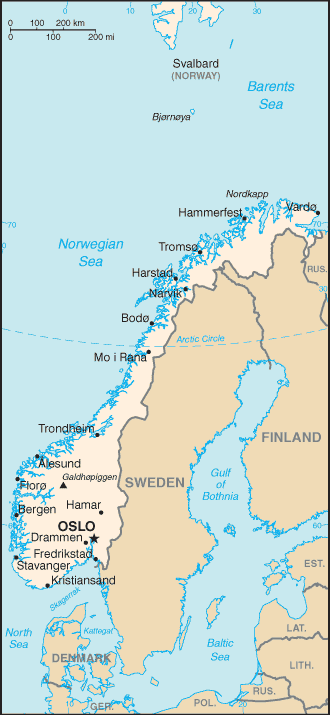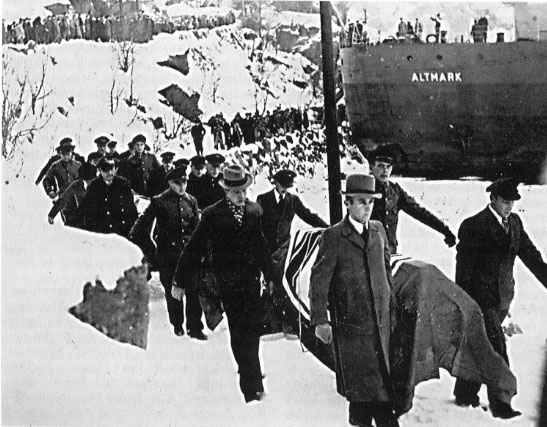|
Plan R 4
Plan R 4 was an unrealised British plan to invade Norway and Sweden in April 1940, during the Second World War. As a result of competing plans for Norway and a German invasion of Norway the same month, it was not carried out as designed. Similar plans had been drawn up during the proposed Anglo-French intervention in the Winter War. Background Germany did not have a sufficient domestic supply of iron ore, which is used in the production of steel. Before the war, large quantities of iron ore had been imported from mines in the French province of Lorraine. Since September 1939, that supply had no longer been available and so shipments from the other large supplier, Sweden, were essential for the production of tanks, guns, ships, railcars, trucks and other implements of war. In the northern part of the Baltic Sea, the Gulf of Bothnia, lies the Swedish port of Luleå from where in the summer a quantity of ore was shipped. It was frozen in winter, so for several months each year t ... [...More Info...] [...Related Items...] OR: [Wikipedia] [Google] [Baidu] |
Swedish Iron Mining During World War II
Swedish iron ore was an important economic and military factor in the European theatre of World War II, as Sweden was the main contributor of iron ore to Nazi Germany. The source of iron ore for Nazi Germany 1933–43 give the following average percentages when added together: Sweden 43.0 Domestic production 28.2 France 12.9. Within the German military the Navy was most dependent on Swedish steel as an absolute necessity to the German war effort, according to their grand admiral. It has also been argued that the Swedish export helped prolong the war. Both the Allies and the Axis were keen to gain control of the mining district in northernmost Sweden, surrounding the mining towns of Gällivare and Kiruna. The importance of this issue increased after other sources of iron were cut off from Germany by the Allied naval blockade during the Battle of the Atlantic. Both the planned Anglo-French support of Finland in the Winter War, and the following German occupation of Denmark and ... [...More Info...] [...Related Items...] OR: [Wikipedia] [Google] [Baidu] |
Naval Mine
A naval mine is a self-contained explosive device placed in water to damage or destroy surface ships or submarines. Unlike depth charges, mines are deposited and left to wait until they are triggered by the approach of, or contact with, any vessel or a particular vessel type, akin to anti-infantry vs. anti-vehicle mines. Naval mines can be used offensively, to hamper enemy shipping movements or lock vessels into a harbour; or defensively, to protect friendly vessels and create "safe" zones. Mines allow the minelaying force commander to concentrate warships or defensive assets in mine-free areas giving the adversary three choices: undertake an expensive and time-consuming minesweeping effort, accept the casualties of challenging the minefield, or use the unmined waters where the greatest concentration of enemy firepower will be encountered. Although international law requires signatory nations to declare mined areas, precise locations remain secret; and non-complying individ ... [...More Info...] [...Related Items...] OR: [Wikipedia] [Google] [Baidu] |
Operation Wilfred
Operation Wilfred was a British naval operation during the Second World War that involved the mining of the channel between Norway and its offshore islands to prevent the transport of Swedish iron ore through neutral Norwegian waters to be used to sustain the German war effort. The Allies assumed that Wilfred would provoke a German response in Norway and prepared a separate operation known as Plan R 4 to occupy Narvik and other important locations. On 8 April 1940, the operation was partly carried out, but was overtaken by events as a result of the following day's German invasion of Norway and Denmark (Operation Weserübung), which instead began the Norwegian Campaign. Background With the outbreak of war on 3 September 1939, Britain and France initiated a naval blockade to weaken Germany by depriving it of the vital imports needed to sustain its war effort. One of the most crucial of these was iron ore, needed to manufacture the steel which was used to build ships, tanks and ... [...More Info...] [...Related Items...] OR: [Wikipedia] [Google] [Baidu] |
Denmark
) , song = ( en, "King Christian stood by the lofty mast") , song_type = National and royal anthem , image_map = EU-Denmark.svg , map_caption = , subdivision_type = Sovereign state , subdivision_name = Danish Realm, Kingdom of Denmark , established_title = History of Denmark#Middle ages, Consolidation , established_date = 8th century , established_title2 = Christianization , established_date2 = 965 , established_title3 = , established_date3 = 5 June 1849 , established_title4 = Faroese home rule , established_date4 = 24 March 1948 , established_title5 = European Economic Community, EEC 1973 enlargement of the European Communities, accession , established_date5 = 1 January 1973 , established_title6 = Greenlandic home rule , established_date6 = 1 May 1979 , official_languages = Danish language, Danish , languages_type = Regional languages , languages_sub = yes , languages = German language, GermanGerman is recognised as a protected minority language in t ... [...More Info...] [...Related Items...] OR: [Wikipedia] [Google] [Baidu] |
Altmark Incident
The ''Altmark'' incident (Norwegian: ''Altmark''-affæren; German: ''Altmark-Zwischenfall'') was a naval incident of World War II between British destroyers and the German tanker ''Altmark'', which happened on 16–17 February 1940. It took place in what were, at that time, neutral Norwegian waters. On board the ''Altmark'' were roughly 300 Allied prisoners (officially internees), whose ships had been sunk by the pocket battleship ''Graf Spee'' in the Southern Atlantic Ocean. British naval forces cornered the tanker and later the destroyer HMS ''Cossack'' boarded the ''Altmark'' near the Jøssingfjord and liberated all the prisoners; eight German sailors were killed and ten wounded during the hand-to-hand fighting which took place during the boarding. A British sailor was also wounded during the fighting. The German government claimed that the boarding was a violation of international law and Norwegian neutrality, and later used the incident in the propaganda broa ... [...More Info...] [...Related Items...] OR: [Wikipedia] [Google] [Baidu] |
United States Army Center Of Military History
The United States Army Center of Military History (CMH) is a directorate within the United States Army Training and Doctrine Command. The Institute of Heraldry remains within the Office of the Administrative Assistant to the Secretary of the Army. The center is responsible for the appropriate use of history and military records throughout the United States Army. Traditionally, this mission has meant recording the official history of the army in both peace and war, while advising the army staff on historical matters. CMH is the flagship organization leading the Army Historical Program. CMH is also in charge of the National Museum of the United States Army, which was recently completed at Fort Belvoir, Virginia. Mission The center traces its lineage back to historians under the Secretary of War who compiled the ''Official Records of the Rebellion'', an extensive history of the American Civil War begun in 1874. A similar work on World War I was prepared by the Historical Section o ... [...More Info...] [...Related Items...] OR: [Wikipedia] [Google] [Baidu] |
Fait Accompli
Many words in the English vocabulary are of French origin, most coming from the Anglo-Norman spoken by the upper classes in England for several hundred years after the Norman Conquest, before the language settled into what became Modern English. English words of French origin, such as ''art'', ''competition'', ''force'', ''machine'', and ''table'' are pronounced according to English rules of phonology, rather than French, and are commonly used by English speakers without any consciousness of their French origin. This article, on the other hand, covers French words and phrases that have entered the English lexicon without ever losing their character as Gallicisms: they remain unmistakably "French" to an English speaker. They are most common in written English, where they retain French diacritics and are usually printed in italics. In spoken English, at least some attempt is generally made to pronounce them as they would sound in French; an entirely English pronunciation is re ... [...More Info...] [...Related Items...] OR: [Wikipedia] [Google] [Baidu] |
Gävle
Gävle () is a city in Sweden, the seat of Gävle Municipality and the capital of Gävleborg County. It had 77,586 inhabitants in 2020, which makes it the 13th most populated city in Sweden. It is the oldest city in the historical Norrland (Sweden's Northern Lands), having received its charter in 1446 from Christopher of Bavaria. However, Gävle is far nearer to the greater Stockholm region than it is to most other major settlements in Norrland and has a much milder climate than associated with said region. In recent years, the city has received much international attention due to its large Yule Goat figure made of straw - the Gävle Goat. The goat is erected in December each year and is often subsequently vandalized, usually by being set on fire. The goat has now become a symbol for the city and is being used for various marketing purposes. History It is believed that the name ''Gävle'' derives from the word ''gavel'', meaning river banks in Old Swedish and referring to th ... [...More Info...] [...Related Items...] OR: [Wikipedia] [Google] [Baidu] |
Sápmi
(, smj, Sábme / Sámeednam, sma, Saepmie, sju, Sábmie, , , sjd, Са̄мь е̄ммьне, Saam' jiemm'n'e) is the cultural region traditionally inhabited by the Sámi people. Sápmi is in Northern and Eastern Europe and includes the northern parts of Fennoscandia, also known as the "Cap of the North". The region stretches over four countries: Norway, Sweden, Finland, and Russia. On the north it is bounded by the Barents Sea, on the west by the Norwegian Sea, and on the east by the White Sea."Lapland." Encyclopædia Britannica. ''Encyclopædia Britannica Online. Encyclopædia Britannica'', 2009. Web. 24 November 2009 http://search.eb.com/eb/article-9047170. The area is historically referred to as Lapland () in English, although the term "Lapp" for its inhabitants is now considered pejorative.; ; Norwegian Sápmi was historically called ''Finnmǫrk'', a name used for the former county Finnmark, now Troms og Finnmark. Sápmi refers to the areas where the Sámi people ... [...More Info...] [...Related Items...] OR: [Wikipedia] [Google] [Baidu] |



